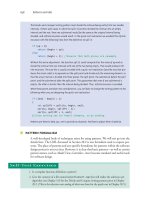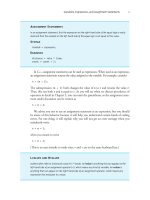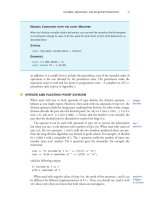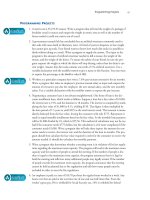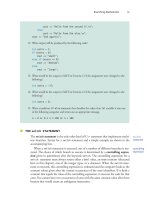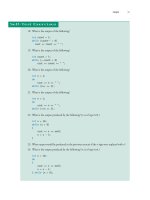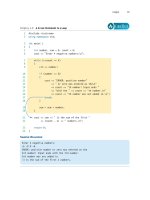Ebook Ethernet networks (4th edition) Part 2
Bạn đang xem bản rút gọn của tài liệu. Xem và tải ngay bản đầy đủ của tài liệu tại đây (5.12 MB, 307 trang )
Ethernet Networks: Design, Implementation, Operation, Management.
Gilbert Held
Copyright 2003 John Wiley & Sons, Ltd.
ISBN: 0-470-84476-0
chapter six
Bridging and Switching
Methods and Performance
Issues
In Chapter 5, an overview of bridge operations was presented, along with
information concerning the functionality of other local area network hardware and software components. That chapter deferred until now a detailed
examination of bridging methods, to include their network use and performance issues. In this chapter, we will focus our attention on those issues,
examining different methods that bridges use for routing frames, performance
issues that govern their ability to examine and forward frames without introducing network bottlenecks, and their typical employment for interconnecting
LANs. Because LAN switches represent a special type of multiport bridge, we
will also focus our attention upon this topic later in this chapter. Thus, once
we have an appreciation for the operation and utilization of bridges, we will
turn our attention to LAN switches.
6.1 Bridging Methods
Bridges operate by examining MAC layer addresses, using the destination
and source addresses within a frame as a decision criterion to make their
forwarding decisions. Operating at the MAC layer, bridges are not addressed,
and must therefore examine all frames that flow on a network. Because bridges
operate at the MAC layer, they in effect terminate a collision domain. That is,
if a collision is detected upon one port of a bridge, it is not propagated onto
any output port. This means that, unlike a repeater, a bridge can be used to
extend the span of a LAN.
279
280
chapter six
Address Issues
Since bridges connect networks, it is important to ensure that duplicate MAC
addresses do not occur on joined internal networks — a topology we will refer
to as an intranet. While duplicate addresses will not occur when universally
administered addressing is used, when locally administered addressing is
used duplicate addresses become possible. Thus, the addresses assigned to
stations on separate networks joined to form an intranet should be reviewed
before using bridges to connect two or more separate networks.
Two primary routing methods are used by bridges for connecting wired local
area networks: transparent or self-learning and source routing. Transparent
bridges were originally developed to support the connection of Ethernet
networks, as briefly described in Chapter 5.
Transparent Bridging
A transparent bridge examines MAC frames to learn the addresses of stations
on the network, storing information in internal memory in the form of an
address table. Thus, this type of bridge is also known as a self-learning
bridge. To understand the operation of a transparent bridge in more detail
and realize some of the limitations associated with the use of this device,
consider the simple intranet illustrated in Figure 6.1. This intranet consists
C
A
Ethernet 3
Ethernet 2
Ethernet 1
E
D
F
B
Port 1
Bridge 1
Bridge 1 port / address table
Port 1
A
B
Port 2
C
D
E
F
Port 2
Port 1
Bridge 2
Port 2
Bridge 2 port / address table
Port 1
A
B
C
D
Port 2
E
F
Figure 6.1 Transparent bridge operation. A transparent or self-learning
bridge examines the source and destination addresses to form port/address or
routing tables in memory.
bridging and switching methods and performance issues
281
of three Ethernet local area network segments connected through the use of
two self-learning bridges. For simplicity of illustration, only two workstations
are shown and labeled on each local area network. Those labels represent the
48-bit MAC address of each station.
Port/Address Table Construction
As previously noted in Chapter 5, a bridge constructs its port/address table
by using what can be referred to as the ‘‘three F’s’’ — flooding, filtering, and
forwarding. If a bridge encounters a frame with a destination address that is
not in its port/address table, it transmits the frame onto all other ports except
the port it was received on. If the destination address is in its port/address
table and does not represent the port the frame was received on, the bridge
forwards the frame onto the port corresponding to the entry in the table for
the destination address. If the destination address is in the port/address table
and represents the port the frame was received on, there is no need to forward
the frame. Thus, the frame is filtered by the bridge.
In examining the construction of bridge port/address tables for the network
shown in Figure 6.1, we will assume that each bridge operates as a transparent
bridge. As frames flow on the Ethernet, bridge 1 examines the source address
of each frame. Eventually, after both stations A and B have become active, the
bridge associates their address as being on port 1 of that device. Any frames
with a destination address other than stations A or B are considered to be on
another network. Thus, bridge 1 would eventually associate addresses C, D,
E, and F with port 2, once it receives frames with those addresses in their
destination address fields. Similarly, bridge 2 constructs its own port/address
table. Since frames from Ethernet 1 and 1 Ethernet 2 can have source addresses
of A, B, C, or D, eventually the port/address table of bridge 2 associates those
addresses with port 1 of that device. Since frames from Ethernet 1 or Ethernet 2
with a destination address of E or F are not on those local area networks,
bridge 2 then associates those addresses with port 2 of that device.
The port/address tables previously shown in Figure 6.1 are normally stored
in bridge memory sorted by MAC address. In addition, the time the entry
occurred is also added to the table, resulting in a three-column table. The
time of occurrence is used by bridges to periodically purge old entries. Entry
purging is important because inactive entries both use finite memory and
extend the search time associated with the reading of each frame received
on a bridge port and its comparison to entries in the port/address table. This
searching is required to determine if the frame is to be forwarded along with
the port onto which the frame should be placed.
282
chapter six
Advantages
One of the key advantages of a transparent bridge is that it operates independently of the contents of the information field and is protocol-independent.
Because this type of bridge is self-learning, it requires no manual configuration
and is essentially a ‘‘plug and play’’ device. Thus, this type of bridge is attractive for connecting a few local area networks together, and is usually sufficient
for most small and medium-sized businesses. Unfortunately, its use limits the
development of certain interconnection topologies, as we will soon see.
Disadvantages
To see the disadvantages associated with transparent bridges, consider
Figure 6.2, in which the three Ethernet local area networks are interconnected
through the use of three bridges. In this example, the interconnected networks
form a circular or loop topology. Because a transparent bridge views stations
as being connected to either port 1 or port 2, a circular or loop topology will
create problems. Those problems can result in an unnecessary duplication
of frames, which not only degrades the overall level of performance of the
Ethernet 1
Ethernet 2
B
A
E
Port 1
Bridge 1
F
Port 2
Port 1
Port 1
Bridge 2
Bridge 3
Port 2
Port 2
Ethernet 3
C
D
Figure 6.2 Transparent bridges do not support network loops. The construction of a circular or loop topology with transparent bridges can result in an
unnecessary duplication of frames, and may confuse end stations. To avoid
these problems, the Spanning Tree Protocol (STP) opens a loop by placing
one bridge in a standby mode of operation.
bridging and switching methods and performance issues
283
interconnected networks, but will quite possibly confuse the end stations. For
example, consider a frame whose source address is A and whose destination
address is F. Both bridge 1 and bridge 2 will forward the frame. Although
bridge 1 will forward the frame to its appropriate network using the most
direct route, the frame will also be forwarded via bridge 2 and bridge 3
to Ethernet 2, resulting in a duplicate frame arriving at workstation F. At
station F, a mechanism would be required to reject duplicate frames. Even if
such a mechanism is available, the additional traffic flowing across multiple
internet paths would result in an increase in network usage. This, in turn,
would saturate some networks, while significantly reducing the level of
performance of other networks. For these reasons, transparent bridging is
prohibited from creating a loop or circular topology. However, transparent
bridging supports concurrently active multiple bridges, using an algorithm
known as the spanning tree to determine which bridges should forward and
which bridges should only filter frames.
Spanning Tree Protocol
The problem of active loops was addressed by the IEEE Committee 802 in
the 802.1D standard with an intelligent algorithm known as the Spanning
Tree Protocol (STP). The STP, based on graph theory, converts a loop into a
tree topology by disabling a link. This action ensures there is a unique path
from any node in an intranet to every other node. Disabled nodes are then
kept in a standby mode of operation until a network failure occurs. At that
time, the STP will attempt to construct a new tree using any of the previously
disabled links.
Operation
To illustrate the operation of the STP, we must first become familiar with
the difference between the physical and active topology of bridged networks.
In addition, there are a number of terms associated with the spanning tree
algorithm, as defined by the protocol, that we should become familiar with.
Thus, we will also review those terms before discussing the operation of
the algorithm.
Physical versus Active Topology
In transparent bridging, a distinction is made between the physical and active
topology resulting from bridged local area networks. This distinction enables
the construction of a network topology in which inactive but physically
284
chapter six
constructed routes can be placed into operation if a primary route should fail,
and in which the inactive and active routes would form an illegal circular
path violating the spanning tree algorithm if both routes were active at the
same time.
The top of Figure 6.3 illustrates one possible physical topology of bridged
networks. The cost (C) assigned to each bridge will be discussed later in this
chapter. The lower portion of Figure 6.3 illustrates a possible active topology
for the physical configuration shown at the top of that illustration.
When a bridge is used to construct an active path, it will forward frames
through those ports used to form active paths. The ports through which
frames are forwarded are said to be in a forwarding state of operation. Ports
that cannot forward frames because their operation forms a loop are said to be
in a blocking state of operation.
Under the spanning tree algorithm, a port in a blocking state can be placed
into a forwarding state to provide a path that becomes part of the active
network topology. This new path usually occurs because of the failure of
another path, bridge component, or the reconfiguration of interconnected
networks, and must not form a closed loop.
Spanning Tree Algorithm
The basis for the spanning tree algorithm is a tree structure, since a tree forms
a pattern of connections that has no loops. The term spanning is used because
the branches of a tree structure span or connect subnetworks.
As a review for readers unfamiliar with graph theory, let’s examine the
concept behind spanning trees. To appropriately do so we need a point
of reference, so let’s begin with the graph structure shown at the top of
Figure 6.4. A spanning tree of a graph is a subgraph that connects all nodes and
represents a tree. The graph shown at the top of Figure 6.4 has eight distinct
spanning trees. The lower portion of Figure 6.4 illustrates the spanning trees
associated with the graph structure illustrated at the top of the previously
referenced figure.
Minimum Spanning Tree
Suppose the links connecting each node are assigned a length or weight. Then,
the weight of a tree represents the sum of its links or edges. If the weight
or length of the links or tree edges differ, then different tree structures will
have different weights. Thus, the identification of the minimum spanning tree
requires us to examine each of the spanning trees supported by a graph and
identify the structure that has the minimum length or weight.
bridging and switching methods and performance issues
285
Token-ring 1
B1
C =10
Ethernet 2
Ethernet 1
B2
C =10
B4
C =15
B3
C =15
Token-ring 2
B5
C =10
Ethernet 3
(a) Physical topology
Token-ring 1
B2
B1
B3
Ethernet 1
Token-ring 2
Legend: B = Bridge
C = Cost
Ethernet 2
B4
B5
Ethernet 3
(b) Active topology
Figure 6.3 Physical versus active topology. When transparent bridges are
used, the active topology cannot form a closed loop in the intranet.
286
chapter six
(a) Network graph
(b) Possible spanning trees
Figure 6.4
Forming spanning trees from a network graph.
The identification of the minimum spanning tree can be accomplished
by listing all spanning trees and finding the minimum weight or length
associated with the list. This is a brute force method that always works but
is not exactly efficient, especially when a graph becomes complex and can
contain a significant number of trees. A far better method is obtained by the
use of an appropriate algorithm.
Kruskal’s Algorithm
There are several popular algorithms developed for solving the minimum
spanning tree of a graph. One of those algorithms is the Kruskal algorithm
which is relatively easy to understand and will be used to illustrate the
computation of a minimum spanning tree. Because we need weights or
lengths assigned to each edge or link in a graph, let’s revise the network graph
previously shown in Figure 6.4 and add some weights. Figure 6.5 illustrates
the weighted graph.
bridging and switching methods and performance issues
8
B
A
1
3
4
6
C
287
D
Figure 6.5
A weighted network graph.
Kruskal’s algorithm can be expressed as follows:
1. Sort the edges of the graph (G) in their increasing order by weight
or length.
2. Construct a subgraph (S) of G and initially set it to the empty state.
3. For each edge (e) in sorted order:
If the endpoints of the edges (e) are disconnected in S, add them to S.
Using the graph shown in Figure 6.5, let’s apply Kruskal’s algorithm
as follows:
1. The sorted edges of the graph in their increasing order by weight or
length produces the following table:
Edge
Weight/Length
A-C
1
B-D
3
C-B
4
C-D
6
A-B
8
2. Set the subgraph of G to the empty state. Thus, S = null.
3. For each edge add to S as long as the endpoints are disconnected. Thus,
the first operation produces:
A
S = A,C
or
C
288
chapter six
The next operation produces:
S = (A,C) + (B,D)
A
B
C
D
or
The third operation produces:
S = (A,B) + (B,D) + (C,B)
A
B
C
D
or
Note that we cannot continue as the endpoints in S are now all connected.
Thus, the minimum spanning tree consists of the edges or links (A, B) +
(B, D) + (C, B) and has the weight 1 + 4 + 3, or 7. Now that we have an
appreciation for the method by which a minimum spanning tree is formed, let’s
turn our attention to its applicability in transparent bridge-based networks.
Similar to the root of a tree, one bridge in a spanning tree network will
be assigned to a unique position in the network. Known as the root bridge,
this bridge is assigned as the top of the spanning tree, and because of this
position, it has the potential to carry the largest amount of intranet traffic due
to its position.
Because bridges and bridge ports can be active or inactive, a mechanism
is required to identify bridges and bridge ports. Each bridge in a spanning
tree network is assigned a unique bridge identifier. This identifier is the MAC
address on the bridge’s lowest port number and a two-byte bridge priority
level. The priority level is defined when a bridge is installed and functions
as a bridge number. Similar to the bridge priority level, each adapter on
a bridge that functions as a port has a two-byte port identifier. Thus, the
unique bridge identifier and port identifier enable each port on a bridge to be
uniquely identified.
Path Cost
Under the spanning tree algorithm, the difference in physical routes between
bridges is recognized, and a mechanism is provided to indicate the preference
for one route over another. That mechanism is accomplished by the ability
bridging and switching methods and performance issues
289
to assign a path cost to each path. Thus, you could assign a low cost to a
preferred route and a high cost to a route you only want to be used in a
backup situation.
Once path costs are assigned to each path in an intranet, each bridge will
have one or more costs associated with different paths to the root bridge. One
of those costs is lower than all other path costs. That cost is known as the
bridge’s root path cost, and the port used to provide the least path cost toward
the root bridge is known as the root port.
Designated Bridge
As previously discussed, the spanning tree algorithm does not permit active
loops in an interconnected network. To prevent this situation from occurring,
only one bridge linking two networks can be in a forwarding state at any
particular time. That bridge is known as the designated bridge, while all other
bridges linking two networks will not forward frames and will be in a blocking
state of operation.
Constructing the Spanning Tree
The spanning tree algorithm employs a three-step process to develop an active
topology. First, the root bridge is identified. To accomplish this, each bridge
in the intranet will initially assume it is the root bridge. To determine which
bridge should actually act as the root bridge, each bridge will periodically
transmit bridge protocol data unit (BPDU) frames that are described in the
following section. BPDU frames under Ethernet version 2 are referred to as
HELLO frames or messages and are transmitted on all bridge ports. Each
BPDU frame includes the priority of the bridge defined at installation time. As
the bridges in the intranet periodically transmit their BPDU frames, bridges
receiving a BPDU with a lower priority value than its own cease transmitting
their BPDUs; however, they forward BPDUs with a lower priority value.
Thus, after a short period of time the bridge with the lowest priority value
is recognized as the root bridge. In Figure 6.3b we will assume bridge 1 was
selected as the root bridge. Next, the path cost from each bridge to the root
bridge is determined, and the minimum cost from each bridge becomes the
root path cost. The port in the direction of the least path cost to the root
bridge, known as the root port, is then determined for each bridge. If the root
path cost is the same for two or more bridges linking LANs, then the bridge
with the highest priority will be selected to furnish the minimum path cost.
Once the paths are selected, the designated ports are activated.
290
chapter six
In examining Figure 6.3a, let us now use the cost entries assigned to
each bridge. Let us assume that bridge 1 was selected as the root bridge,
since we expect a large amount of traffic to flow between Token-Ring 1 and
Ethernet 1 networks. Therefore, bridge 1 will become the designated bridge
between Token-Ring 1 and Ethernet 1 networks. Here the term designated
bridge references the bridge that has the bridge port with the lowest-cost path
to the root bridge.
In examining the path costs to the root bridge, note that the path through
bridge 2 was assigned a cost of 10, while the path through bridge 3 was
assigned a cost of 15. Thus, the path from Token-Ring 2 via bridge 2 to TokenRing 1 becomes the designated bridge between those two networks. Hence,
Figure 6.3b shows bridge 3 inactive by the omission of a connection to the
Token-Ring 2 network. Similarly, the path cost for connecting the Ethernet 3
network to the root bridge is lower by routing through the Token-Ring 2 and
Token-Ring 1 networks. Thus, bridge 5 becomes the designated bridge for the
Ethernet 3 and Token-Ring 2 networks.
Bridge Protocol Data Unit
As previously noted, bridges obtain topology information by the use of
bridge protocol data unit (BPDU) frames. Once a root bridge is selected, that
bridge is responsible for periodically transmitting a ‘‘HELLO’’ BPDU frame
to all networks to which it is connected. According to the spanning tree
protocol, HELLO frames must be transmitted every 1 to 10 seconds. The
BPDU has the group MAC address 800143000000, which is recognized by
each bridge. A designated bridge will then update the path cost and timing
information and forward the frame. A standby bridge will monitor the BPDUs,
but will not update nor forward them. If the designated bridge does not
receive a BPDU on its root port for a predefined period of time (default is
20 seconds), the designated bridge will assume that either a link or device
failure occurred. That bridge, if it is still receiving configuration BPDU frames
on other ports, will then switch its root port to a port that is receiving the best
configuration BPDUs.
When a standby bridge is required to assume the role of the root or designated
bridge, the HELLO BPDU will indicate that a standby bridge should become
a designated bridge. The process by which bridges determine their role in
a spanning tree network is iterative. As new bridges enter a network, they
assume a listening state to determine their role in the network. Similarly,
when a bridge is removed, another iterative process occurs to reconfigure the
remaining bridges.
bridging and switching methods and performance issues
291
Although the STP algorithm procedure eliminates duplicate frames and
degraded intranet performance, it can be a hindrance for situations where
multiple active paths between networks are desired. In addition, if a link or
device fails, the time required for a new spanning tree to be formed via the
transmission of BPDUs can easily require 45 to 60 seconds or more. Another
disadvantage of STP occurs when it is used in remote bridges connecting
geographically dispersed networks. For example, returning to Figure 6.2,
suppose Ethernet 1 were located in Los Angeles, Ethernet 2 in New York, and
Ethernet 3 in Atlanta. If the link between Los Angeles and New York were
placed in a standby mode of operation, all frames from Ethernet 2 routed to
Ethernet 1 would be routed through Atlanta. Depending on the traffic between
networks, this situation might require an upgrade in the bandwidth of the links
connecting each network to accommodate the extra traffic flowing through
Atlanta. Since the yearly cost of upgrading a 56- or 64-Kbps circuit to a 128Kbps fractional T1 link can easily exceed the cost of a bridge or router, you
might wish to consider the use of routers to accommodate this networking
situation. In comparison, when using local bridges, the higher operating
rate of local bridges in interconnecting local area networks normally allows
an acceptable level of performance when LAN traffic is routed through an
intermediate bridge.
Protocol Dependency
Another problem associated with the use of transparent bridges concerns the
differences between Ethernet and IEEE 802.3 frame field compositions. As
noted in Chapter 4, the Ethernet frame contains a type field that indicates
the higher-layer protocol in use. Under the IEEE 802.3 frame format, the type
field is replaced by a length field, and the data field is subdivided to include
logical link control (LLC) information in the form of destination (DSAP) and
source (SSAP) service access points. Here, the DSAP and SSAP are similar to
the type field in an Ethernet frame: they also point to a higher-level process.
Unfortunately, this small difference can create problems when you are using
a transparent bridge to interconnect Ethernet and IEEE 802.3 networks.
The top portion of Figure 6.6 shows the use of a bridge to connect an
AppleTalk network supporting several Macintosh computers to an Ethernet
network on which a Digital Equipment Corporation VAX computer is located.
Although the VAX may be capable of supporting DecNet Phase IV, which
is true Ethernet, and AppleTalk if both modules are resident, a pointer is
required to direct the IEEE 802.3 frames generated by the Macintosh to
the right protocol on the VAX. Unfortunately, the Ethernet connection used
292
chapter six
Apple
Dec
phase IV talk
Ethernet NIC
Ethernet
B
IEEE 802.3
M
M
Frame differences
Ethernet
Type
Information
IEEE 802.3
Length
Information
DSAP SSAP Control
Information
Legend:
= Workstation
M = Macintosh
Figure 6.6 Protocol differences preclude linking IEEE 802.3 and Ethernet
networks using transparent bridges. A Macintosh computer connected on an
IEEE 802.3 network using AppleTalk will not have its frame pointed to the
right process on a VAX on an Ethernet. Thus, the differences between Ethernet
and IEEE 802.3 networks require transparent bridges for interconnecting
similar networks.
by the VAX will not provide the required pointer. This explains why you
should avoid connecting Ethernet and IEEE 802.3 networks via transparent
bridges. Fortunately, almost all Ethernet NICs manufactured today are IEEE
802.3–compatible to alleviate this problem; however, older NICs may operate
as true Ethernets and result in the previously mentioned problem.
Source Routing
Source routing is a bridging technique developed by IBM for connecting
Token-Ring networks. The key to the implementation of source routing is the
bridging and switching methods and performance issues
293
use of a portion of the information field in the Token-Ring frame to carry
routing information and the transmission of discovery packets to determine
the best route between two networks.
The presence of source routing is indicated by the setting of the first bit
position in the source address field of a Token-Ring frame to a binary 1. When
set, this indicates that the information field is preceded by a route information
field (RIF), which contains both control and routing information.
The RIF Field
Figure 6.7 illustrates the composition of a Token-Ring RIF. This field is
variable in length and is developed during a discovery process, described
later in this section.
Field format
Up to 16 bytes
2 bytes
Control
Ring #
Bridge #
B B B L L L L L D LF LF LF LF R R R
Ring #
Ring #
12 bits
Bridge #
Bridge #
4 bits
B are broadcast bits
Bit settings
Designator
Nonbroadcast
0XX
All-routes broadcast
10X
Single route broadcast
11X
L are length bits which denote length of the RIF in bytes
D is direction bit
LF identifies largest frame
Bit settings
Size in bytes
000
001
010
011
100
101
110
111
R are reserved bits
516
1500
2052
4472
8191
Reserved
Reserved
Used in all-routes broadcast frame
Figure 6.7 Token-Ring route information field. The Token-Ring RIF is variable in length.
294
chapter six
The control field contains information that defines how information will be
transferred and interpreted and what size the remainder of the RIF will be. The
three broadcast bit positions indicate a nonbroadcast, all-routes broadcast, or
single-route broadcast situation. A nonbroadcast designator indicates a local
or specific route frame. An all-routes broadcast designator indicates that a
frame will be transmitted along every route to the destination station. A
single-route broadcast designator is used only by designated bridges to relay
a frame from one network to another. In examining the broadcast bit settings
shown in Figure 6.7, note that the letter X indicates an unspecified bit setting
that can be either a 1 or 0.
The length bits identify the length of the RIF in bytes, while the D bit
indicates how the field is scanned, left to right or right to left. Since vendors
have incorporated different memory in bridges which may limit frame sizes,
the LF bits enable different devices to negotiate the size of the frame. Normally,
a default setting indicates a frame size of 512 bytes. Each bridge can select
a number, and if it is supported by other bridges, that number is then used
to represent the negotiated frame size. Otherwise, a smaller number used
to represent a smaller frame size is selected, and the negotiation process is
repeated. Note that a 1500-byte frame is the largest frame size supported
by Ethernet IEEE 802.3 networks. Thus, a bridge used to connect Ethernet
and Token-Ring networks cannot support the use of Token-Ring frames
exceeding 1500 bytes.
Up to eight route number subfields, each consisting of a 12-bit ring number
and a 4-bit bridge number, can be contained in the routing information field.
This permits two to eight route designators, enabling frames to traverse up
to eight rings across seven bridges in a given direction. Both ring numbers
and bridge numbers are expressed as hexadecimal characters, with three hex
characters used to denote the ring number and one hex character used to
identify the bridge number.
Operation Example
To illustrate the concept behind source routing, consider the intranet illustrated in Figure 6.8. In this example, let us assume that two Token-Ring
networks are located in Atlanta and one network is located in New York.
Each Token-Ring and bridge is assigned a ring or bridge number. For simplicity, ring numbers R1, R2, and R3 are used here, although as previously
explained, those numbers are actually represented in hexadecimal. Similarly, bridge numbers are shown here as B1, B2, B3, B4, and B5 instead of
hexadecimal characters.
bridging and switching methods and performance issues
295
0 R3 B2 R1 B1 R1 A
A
C
A
B1 R1 A
B
R1
R3
B2
B1
D
New York
B3
Atlanta
B5
0 R3 B5 R2 B4 R2 B3 R1 A
B3 R1 A
R2
B4
B4 R2 B3 R1 A
Figure 6.8 Source routing discovery operation. The route discovery process
results in each bridge entering the originating ring number and its bridge
number into the RIF.
When a station wants to originate communications, it is responsible for
finding the destination by transmitting a discovery packet to network bridges
and other network stations whenever it has a message to transmit to a new
destination address. If station A wishes to transmit to station C, it sends a
route discovery packet containing an empty RIF and its source address, as
indicated in the upper left portion of Figure 6.8. This packet is recognized
by each source routing bridge in the network. When a source routing bridge
receives the packet, it enters the packet’s ring number and its own bridge
identifier in the packet’s routing information field. The bridge then transmits
the packet to all of its connections except the connection on which the packet
was received, a process known as flooding. Depending on the topology of the
interconnected networks, it is more than likely that multiple copies of the
discovery packet will reach the recipient. This is illustrated in the upper right
corner of Figure 6.8, in which two discovery packets reach station C. Here, one
packet contains the sequence R1B1R1B2R30 — the zero indicates that there is
no bridging in the last ring. The second packet contains the route sequence
R1B3R2B4R2B5R30. Station C then picks the best route, based on either the
most direct path or the earliest arriving packet, and transmits a response to
296
chapter six
the discover packet originator. The response indicates the specific route to
use, and station A then enters that route into memory for the duration of the
transmission session.
Under source routing, bridges do not keep routing tables like transparent
bridges. Instead, tables are maintained at each station throughout the network.
Thus, each station must check its routing table to determine what route frames
must traverse to reach their destination station. This routing method results
in source routing using distributed routing tables instead of the centralized
routing tables used by transparent bridges.
Advantages
There are several advantages associated with source routing. One advantage is
the ability to construct mesh networks with loops for a fault-tolerant design;
this cannot be accomplished with the use of transparent bridges. Another
advantage is the inclusion of routing information in the information frames.
Several vendors have developed network management software products that
use that information to provide statistical information concerning intranet
activity. Those products may assist you in determining how heavily your
wide area network links are being used, and whether you need to modify the
capacity of those links; they may also inform you if one or more workstations
are hogging communications between networks.
Disadvantages
Although the preceding advantages are considerable, they are not without
a price. That price includes a requirement to identify bridges and links
specifically, higher bursts of network activity, and an incompatibility between
Token-Ring and Ethernet networks. In addition, because the structure of the
Token-Ring RIF supports a maximum of seven entries, routing of frames is
restricted to crossing a maximum of seven bridges.
When using source routing bridges to connect Token-Ring networks, you
must configure each bridge with a unique bridge/ring number. In addition,
unless you wish to accept the default method by which stations select a frame
during the route discovery process, you will have to reconfigure your LAN
software. Thus, source routing creates an administrative burden not incurred
by transparent bridges.
Due to the route discovery process, the flooding of discovery frames occurs in
bursts when stations are turned on or after a power outage. Depending upon
the complexity of an intranet, the discovery process can degrade network
bridging and switching methods and performance issues
297
performance. This is perhaps the most problematic for organizations that
require the interconnection of Ethernet and Token-Ring networks.
A source routing bridge can be used only to interconnect Token-Ring
networks, since it operates on RIF data not included in an Ethernet frame.
Although transparent bridges can operate in Ethernet, Token-Ring, and mixed
environments, their use precludes the ability to construct loop or mesh
topologies, and inhibits the ability to establish operational redundant paths
for load sharing. Another problem associated with bridging Ethernet and
Token-Ring networks involves the RIF in a Token-Ring frame. Unfortunately,
different LAN operating systems use the RIF data in different ways. Thus,
the use of a transparent bridge to interconnect Ethernet and Token-Ring
networks may require the same local area network operating system on each
network. To alleviate these problems, several vendors introduced source
routing transparent (SRT) bridges, which function in accordance with the
IEEE 802.1D standard approved during 1992.
Source Routing Transparent Bridges
A source routing transparent bridge supports both IBM’s source routing and
the IEEE transparent STP operations. This type of bridge can be considered
two bridges in one; it has been standardized by the IEEE 802.1 committee as
the IEEE 802.1D standard.
Operation
Under source routing, the MAC packets contain a status bit in the source field
that identifies whether source routing is to be used for a message. If source
routing is indicated, the bridge forwards the frame as a source routing frame. If
source routing is not indicated, the bridge determines the destination address
and processes the packet using a transparent mode of operation, using routing
tables generated by a spanning tree algorithm.
Advantages
There are several advantages associated with source routing transparent
bridges. First and perhaps foremost, they enable different networks to use
different local area network operating systems and protocols. This capability enables you to interconnect networks developed independently of one
another, and allows organization departments and branches to use LAN
operating systems without restriction. Secondly, also a very important consideration, source routing transparent bridges can connect Ethernet and
298
chapter six
Token-Ring networks while preserving the ability to mesh or loop TokenRing networks. Thus, their use provides an additional level of flexibility for
network construction.
Translating Operations
When interconnecting Ethernet/IEEE 802.3 and Token-Ring networks, the
difference between frame formats requires the conversion of frames. A bridge
that performs this conversion is referred to as a translating bridge.
As previously noted in Chapter 4, there are several types of Ethernet frames,
such as Ethernet, IEEE 802.3, Novell’s Ethernet-802.3, and Ethernet-SNAP.
The latter two frames represent variations of the physical IEEE 802.3 frame
format. Ethernet and Ethernet-802.3 do not use logical link control, while IEEE
802.3 CSMA/CD LANs specify the use of IEEE 802.2 logical link control. In
comparison, all IEEE 802.5 Token-Ring networks either directly or indirectly
use the IEEE 802.2 specification for logical link control.
The conversion from IEEE 802.3 to IEEE 802.5 can be accomplished by
discarding portions of the IEEE 802.3 frame not applicable to a TokenRing frame, copying the 802.2 LLC protocol data unit (PDU) from one
frame to another, and inserting fields applicable to the Token-Ring frame.
Figure 6.9 illustrates the conversion process performed by a translating bridge
IEEE 802.3
Preamble DA SA Length DSAP SSAP Control
Discard
insert
Discard
insert
Copy
SD AC FC DA SA
RIF
Information
Discard
insert
Copy
DSAP SSAP Control
FCS
Information FCS ED FS
Legend:
DA
SA
AC
FC
RIF
DSAP
SSAP
ED
FS
= Destination Address
= Source Address
= Access Control
= Frame Control
= Routing Information Field
= Destination Service Access Point
= Source Service Access Point
= End Delimiter
= Frame Status Field
Figure 6.9
IEEE 802.3 to 802.5 frame conversion.
bridging and switching methods and performance issues
299
Ethernet
Preamble DA SA
Tokenring
Discard
insert
Type
Copy
Copy
SD AC FC DA SA
Data
RIF
FCS
FCS
Discard
insert
DSAP SSAP Control OC Type Data FCS
ED FS
Legend:
DA
SA
AC
FC
RIF
DSAP
SSAP
ED
FS
OC
Figure 6.10
= Destination Address
= Source Address
= Access Control
= Frame Control
= Routing Information Field
= Destination Service Access Point
= Source Service Access Point
= End Delimiter
= Frame Status Field
= Organization Code
Ethernet to Token-Ring frame conversion.
linking an IEEE 802.3 network to an IEEE 802.5 network. Note that fields
unique to the IEEE 802.3 frame are discarded, while fields common to both
frames are copied. Fields unique to the IEEE 802.5 frame are inserted by
the bridge.
Since an Ethernet frame, as well as Novell’s Ethernet-802.3 frame, does not
support logical link control, the conversion process to IEEE 802.5 requires
more processing. In addition, each conversion is more specific and may or
may not be supported by a specific translating bridge. For example, consider
the conversion of Ethernet frames to Token-Ring frames. Since Ethernet does
not support LLC PDUs, the translation process results in the generation of a
Token-Ring-SNAP frame. This conversion or translation process is illustrated
in Figure 6.10.
6.2 Bridge Network Utilization
In this section, we will examine the use of bridges to interconnect separate
local area networks and to subdivide networks to improve performance.
In addition, we will focus our attention on how we can increase network
300
chapter six
availability by employing bridges to provide alternate communications paths
between networks.
Serial and Sequential Bridging
The top of Figure 6.11 illustrates the basic use of a bridge to interconnect two
networks serially. Suppose that monitoring of each network indicates a high
level of intranetwork use. One possible configuration to reduce intra-LAN
traffic on each network can be obtained by moving some stations off each of
the two existing networks to form a third network. The three networks would
then be interconnected through the use of an additional bridge, as illustrated
in the middle portion of Figure 6.11. This extension results in sequential or
cascaded bridging, and is appropriate when intra-LAN traffic is necessary but
minimal. This intranet topology is also extremely useful when the length of an
Ethernet must be extended beyond the physical cabling of a single network. By
locating servers appropriately within each network segment, you may be able
to minimize inter-LAN transmission. For example, the first network segment
could be used to connect marketing personnel, while the second and third
segments could be used to connect engineering and personnel departments.
This might minimize the use of a server on one network by persons connected
to another network segment.
A word of caution is in order concerning the use of bridges. Bridging
forms what is referred to as a flat network topology, because it makes its
forwarding decisions using layer 2 MAC addresses, which cannot distinguish
one network from another. This means that broadcast traffic generated on
one segment will be bridged onto other segments which, depending upon
the amount of broadcast traffic, can adversely affect the performance on
other segments.
The only way to reduce broadcast traffic between segments is to use a
filtering feature included with some bridges or install routers to link segments. Concerning the latter, routers operate at the network layer and forward
packets explicitly addressed to a different network. Through the use of network addresses for forwarding decisions, routers form hierarchical structured
networks, eliminating the so-called broadcast storm effect that occurs when
broadcast traffic generated from different types of servers on different segments
are automatically forwarded by bridges onto other segments.
Both serial and sequential bridging are applicable to transparent, source
routing, and source routing transparent bridges that do not provide redundancy nor the ability to balance traffic flowing between networks. Each of these
deficiencies can be alleviated through the use of parallel bridging. However,
bridging and switching methods and performance issues
301
Serial bridging
B
Sequential or cascaded bridging
B
B
Parallel bridging
B
B
Figure 6.11
Legend:
= Workstation
B = Bridge
Serial, sequential, and parallel bridging.
this bridging technique creates a loop and is only applicable to source routing
and source routing transparent bridges.
Parallel Bridging
The lower portion of Figure 6.11 illustrates the use of parallel bridges to
interconnect two Token-Ring networks. This bridging configuration permits
302
chapter six
one bridge to back up the other, providing a level of redundancy for linking
the two networks as well as a significant increase in the availability of one
network to communicate with another. For example, assume the availability
of each bridge used at the top of Figure 6.11 (serial bridging) and bottom
of Figure 6.11 (parallel bridging) is 90 percent. The availability through two
serially connected bridges would be 0.9 × 0.9 (availability of bridge 1 ×
availability of bridge 2), or 81 percent. In comparison, the availability through
parallel bridges would be 1 − (0.1 × 0.1), which is 99 percent.
The dual paths between networks also improve inter-LAN communications
performance, because communications between stations on each network can
be load balanced. The use of parallel bridges can thus be expected to provide a
higher level of inter-LAN communications than the use of serial or sequential
bridges. However, as previously noted, this topology is not supported by
transparent bridging.
Star Bridging
With a multiport bridge, you can connect three or more networks to form a
star intranet topology. The top portion of Figure 6.12 shows the use of one
bridge to form a star topology by interconnecting four separate networks.
This topology, or a variation on this topology, could be used to interconnect
networks on separate floors within a building. For example, the top network
could be on floor N + 1, while the bottom network could be on floor N − 1 in
a building. The bridge and the two networks to the left and right of the bridge
might then be located on floor N.
Although star bridging permits several networks located on separate floors
within a building to be interconnected, all intranet data must flow through
one bridge. This can result in both performance and reliability constraints to
traffic flow. Thus, to interconnect separate networks on more than a few floors
in a building, you should consider using backbone bridging.
Backbone Bridging
The lower portion of Figure 6.12 illustrates the use of backbone bridging. In
this example, one network runs vertically through a building with Ethernet
ribs extending from the backbone onto each floor. Depending upon the amount
of intranet traffic and the vertical length required for the backbone network,
the backbone can be either a conventional Ethernet bus-based network or a
fiber-optic backbone.
bridging and switching methods and performance issues
303
Star bridging
B
Backbone bridging
B
B
B
Legend:
B
= Workstation
= Bridge
Figure 6.12
Star and backbone bridging.
6.3 Bridge Performance Issues
The key to obtaining an appropriate level of performance when interconnecting networks is planning. The actual planning process will depend upon
several factors, such as whether separate networks are in operation, the type
of networks to be connected, and the type of bridges to be used — local
or remote.
Traffic Flow
If separate networks are in operation and you have appropriate monitoring
equipment, you can determine the traffic flow on each of the networks to be
